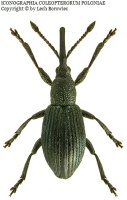Підтримуємо Вільну Україну
 We Support Free Ukraine
We Support Free Ukraine

Biodiversity Map
Taxa

Echinostroma — subordinate taxa:
Taxon count: 2
-
Arthropodaphylum
Click to switch
to select orders
and filters > -
Hexapodasubphylum
Click to switch
to select orders
and filters > -
Insectaclass
Click to switch
to select orders
and filters > -
Coleopteraorder
Click to set
as the main taxon
and as a base
← of the left panel > -
Polyphagasuborder
Click to set
as the main taxon
and as a base
← of the left panel > -
Cucujiformiaseries
Click to set
as the main taxon
and as a base
← of the left panel > -
Curculionoideasuperfamily
Click to set
as the main taxon
and as a base
← of the left panel > -
Apionidaefamily
Click to set
as the main taxon
and as a base
← of the left panel > -
Apioninaesubfamily
Click to set
as the main taxon
and as a base
← of the left panel > -
Ceratapiinitribe
Click to set
as the main taxon
and as a base
← of the left panel > -
Ceratapiongenus
Click to set
as the main taxon
and as a base
← of the left panel > -
Echinostromasubgenus
Click to set
as the main taxon
and as a base
← of the left panel > -
Ceratapion penetransspecies
Click to set
as the main taxon
and as a base
← of the left panel >
PL
YES
name status: valid name
BioMap ID: 1026913
taxon code: 4911
taxonomy checked: YES
Data on distribution in Poland

Statistics
- Records: 255
- Publications: 70
- Collections: 7
- Publication authors: 54
- Illustrations (iconography): 1
- Photos (specimen/observation): lacking
Taxon description
Gatunek obejmujący zasięgiem południową, środkową i wschodnią Europę, na północ dociera do Danii i południowej Szwecji, wykazany poza tym z Kaukazu, Kazachstanu, Maroka i Tunezji. W Polsce, chociaż nie znany jeszcze ze wszystkich krain, prawdopodobnie zasiedla cały obszar prócz wyższych partii górskich. Występuje na łąkach, pastwiskach, przydrożach, suchych zboczach i w widnych zaroślach. Rośliną żywicielską jest chaber łąkowy — Centaurea jacea L. chaber nadreński — C. rhenana Bor. Larwa żeruje w szyi korzeniowej. Postać dojrzała spotykana również na chabrze bławatku — C. cyanus L.
Illustrations
... browse
 Ceratapion
Ceratapionpenetrans
penetrans
External data sources
- Ostatnie rekordy
-
1027629
 ×
× Apionidae: Ceratapion penetrans penetrans, PL, Podlasie, Biebrzański P.N., podlaskie, Biebrzański P.N., Basen Południowy buffer zone, 1996, leg. M. Wanat (Wanat 2005d)
Apionidae: Ceratapion penetrans penetrans, PL, Podlasie, Biebrzański P.N., podlaskie, Biebrzański P.N., Basen Południowy buffer zone, 1996, leg. M. Wanat (Wanat 2005d) -
993305
 ×
× Apionidae: Ceratapion penetrans penetrans, Babińce, 1935, coll. MiIZ PAN: Tenenbaum Sz.
Apionidae: Ceratapion penetrans penetrans, Babińce, 1935, coll. MiIZ PAN: Tenenbaum Sz. -
993304
 ×
× Apionidae: Ceratapion penetrans penetrans, Obiżowa, coll. MiIZ PAN: Tenenbaum Sz.
Apionidae: Ceratapion penetrans penetrans, Obiżowa, coll. MiIZ PAN: Tenenbaum Sz. -
993303
 ×
× Apionidae: Ceratapion penetrans penetrans, Zaleszczyki, 1932, coll. MiIZ PAN: Tenenbaum Sz.
Apionidae: Ceratapion penetrans penetrans, Zaleszczyki, 1932, coll. MiIZ PAN: Tenenbaum Sz. -
993302
 ×
× Apionidae: Ceratapion penetrans penetrans, Kołodróbka, coll. MiIZ PAN: Tenenbaum Sz.
Apionidae: Ceratapion penetrans penetrans, Kołodróbka, coll. MiIZ PAN: Tenenbaum Sz. -
993301
 ×
× Apionidae: Ceratapion penetrans penetrans, Babińce, 1935, coll. MiIZ PAN: Tenenbaum Sz.
Apionidae: Ceratapion penetrans penetrans, Babińce, 1935, coll. MiIZ PAN: Tenenbaum Sz. -
993300
 ×
× Apionidae: Ceratapion penetrans penetrans, Piaseczno, coll. MiIZ PAN: Tenenbaum Sz.
Apionidae: Ceratapion penetrans penetrans, Piaseczno, coll. MiIZ PAN: Tenenbaum Sz. -
993299
 ×
× Apionidae: Ceratapion penetrans penetrans, Babińce, 1935, coll. MiIZ PAN: Tenenbaum Sz.
Apionidae: Ceratapion penetrans penetrans, Babińce, 1935, coll. MiIZ PAN: Tenenbaum Sz. -
993298
 ⊡
⊡ Apionidae: Ceratapion penetrans penetrans, PL, Ojców, UTM DA16, 1902, coll. MiIZ PAN: Tenenbaum Sz.
Apionidae: Ceratapion penetrans penetrans, PL, Ojców, UTM DA16, 1902, coll. MiIZ PAN: Tenenbaum Sz. -
993297
 ×
× Apionidae: Ceratapion penetrans penetrans, Zaleszczyki, 1930, coll. MiIZ PAN: Tenenbaum Sz.
Apionidae: Ceratapion penetrans penetrans, Zaleszczyki, 1930, coll. MiIZ PAN: Tenenbaum Sz. - ... more
- Powiązane publikacje
-
Renner K., Messutat J. 2007. Untersuchungen zur Käferfauna der Umgebung von Skwierzyna im westlichen Polen (Wielkopolska). Coleo, 8:16-20.
 Show records
Show records -
Gosik R. 2006d. Weevils (Curculionoidea) of the middle part of the Bug River Valley. Ann. UMCS, C, 61:7-69.
 Show records
Show records -
Wanat M. 2005d. Ryjkowce (Coleoptera: Curculionoidea bez Scolytinae) Biebrzańskiego Parku Narodowego i jego otuliny. [In:] Dyrcz A., Werpachowski C. (Eds.) Przyroda Biebrzańskiego Parku Narodowego. Osowiec Twierdza. pp. 301-324.
 Show records
Show records -
Petryszak B. 2003. Pędrusie i ryjkowce. [In:] Górecki A., Krzemień K. (Eds.) Przyroda Magurskiego Parku Narodowego. pp. 101-112.
 Show records
Show records -
Mazur M. 2003a. Ryjkowce (Coleoptera: Nemonychidae, Attelabidae, Apionidae, Curculionidae) siedlisk kserotermicznych Polski. II. Szczepanowice koło Miechowa. Wiad. Entomol., 22(3):143-150.
 full text
full text Show records
Show records - ... more
- Powiązane zbiory
-
ISEZ PAN
 Show records
Show records -
Kania J.*
 Show records
Show records -
Kuśka A.*
 Show records
Show records -
MiIZ PAN: Tenenbaum Sz.
 Show records
Show records -
Muz. Górnośląskie, Bytom: Mączyński
 Show records
Show records - ... more
- Wykaz powiązanych pozycji
-
Curculionoidea of Poland
 Show records
Show records





